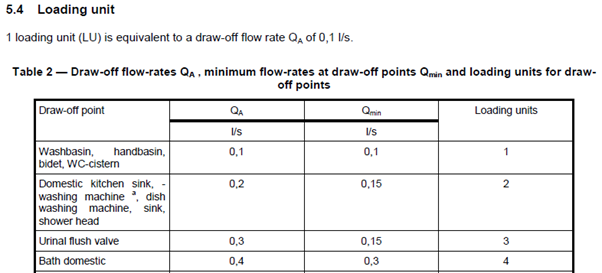The task of engineering a fit-for-purpose domestic cold-water system is multifaceted. Pipe sizing is one such crucial element of this design. The engineering task of sizing domestic water pipework is muddied by the various relevant, and seemingly contradictory, standards and codes of practice available from the various organisations within the field of mechanical built environment engineering. BS EN 806-3 and the Institute of Plumbing (IOP) Design Guide, or the Chartered Institute of Plumbing & Heating Engineering (CIPHE) design guide, are such an example.
Both BS EN 806-3 and IOP Design Guide rely on ‘Loading Units (LU)’ for their pipe sizing methodology. Loading Units are a way of measuring and comparing how much water various appliances within a building, such as taps, toilets, and showers, use in a standardised manner.

The issue occurs with how the different methods realise their ‘Loading Units’. BS EN 806-3 defines a ‘Loading Unit’ as 0.1l/s which CIPHE does not. CIPHE, which in essence adapted and modified BS 6700 (which later became BS 8558), with its modified loading units accounts for low, medium and high appliance use frequency and hence occupancy types.
The UK LU system was conceived when hot and cold water supplies were effectively independent. With the widespread use of mixer taps, the standard methods of measuring effectively double the allowance required resulting in larger, more expensive pumps and pipework.
Referring to the CIPHE Guide or BS8558 within the design stage for domestic pipe sizing, though permitted, would and very often does result in oversized domestic pipework. Resulting in increased initial costs, high running costs, more significant water wastage, and poorer water hygiene.
BS EN 806-3 as guidance for domestic pipework design in many cases is a must. But as with any guidance, its use is up to engineering discretion where unaccounted engineering practicability and feasibility can rear their head.
As the Honorary Chair of the LUNA group, Brian Whorlow BA (Hons) IEng FCIPHE, states in his December 2016 bulletin: “Traditionally, designers have not been particularly concerned about over-sizing, on the basis that this creates a safety factor, but more recently there has been greater attention to water hygiene, energy conservation, sustainable design, and minimising unwanted heat gain.”
We at Sytengral, with our experience in the field, understand the effect oversized domestic pipework can have on mechanical systems as well as clients, contractors and end users. We have experience in determining pragmatic engineering solutions, whether for carbon reduction, budgeting or cost savings.
To get in touch, contact us on 0121 0474 233 or info@syntegral.co.uk




